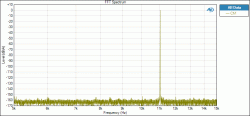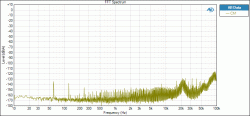Introduction

The exaSound E20 is their flagship stereo DAC. It sells direct from their website for $2500 and is available as a free 30 day trial. First of all, no words can truly explain how good the E20 + Linkwitz Orion actually sounds. My system consists of the Orion 3.5 + Weight and Balance Mod (DIY Sonic Equivalent to the Orion 4.1). A Windows7 PC runs foobar2000 and JRiver Media Center controlled by JRemote on a retina ipad. Asynchronous USB into the E20, which outputs analog into the Orion Analog Signal Processor, which outputs four channels per speaker into an ATI AT1506 with woofers and tweeters bridged to the Linkwitz Orions and no Pre-Amp to color the sound! Interconnects are Blue Jeans LC-1 Low Capacitance Audio Cables. Orion internal wiring provided by BJC Ten Cables, the Orions and AT1506 are connected by 15’ custom 13-guage 8 conductor cable with SPEAKON connectors at the speaker termination and bare wire at the amplifier side.
I am writing this review in the hope that it may help someone objectively if seeking a similar paradigm. I can safely say there is nothing available in my local high end audio stores that have the resolution or natural quality of this combination. When I upgraded, my goal was to obtain the most natural sounding system I could find. The E20 was designed to remove all unnecessary processing from the signal path into the best DAC chip available (ESS Sabre 9018) with custom drivers built from the ground up to offer the best, most natural sounding DAC available.
Specs
Clearly, by looking at specs alone, you can immediately see the E20 boasts some of the most impressive (actually the most impressive) specs I’ve seen for a DAC:
Signal-to-Noise Ratio: 128dB, A-weighted, 2 Vrms
THD+N: 0.0002% @1kHz, 0dBFS
IM Distortion
*: 0.0000079% or -142dB @ 19KHz + 20KHz 0 dBFS 2nd order IMD
DAC Master Clock Jitter: 0.13ps RMS
*Although more importantly is the third order intermodulation distortion (the worst case scenario of everything coming out of your device other than what you put in) of -130dB or below.
Selling Features For Me
1. Besides the top notch specs, the E20 uses an asynchronous USB interface which means it acts as the master and pulls data from the computer when it needs it. All playback happens from the E20’s internal memory so jitter from the computer, not being a real time system, is eliminated.
Here is a 1024 point FFT spectrum averaged four times of 11.025KHz signal at 44.1KHz sampling rate designed to expose the smallest periodic jitter appearing as symmetric sidebands. The only sideband is at -152dBFS:

2. The USB is galvanically isolated from the audio path, and there is virtually no noise from the power line. In fact it is measured at less than -145dB (60Hz noise + harmonics). The galvanic isolation improves the noise level by 30dB!!

Noise floor with galvanic isolation

Noise floor without galvanic isolation
3. The volume control is on the border line between the digital and the analogue domains - internal to the ESS Sabre DAC with 32bit resolution. You will not find bit truncation like other digital attenuation arrangements suffer from. This will also beat all analog attenuation which are unable to match the -135dB noise floor of the DAC.
4. I cannot stress enough how important it is to have solid drivers. Unstable drivers can ruin an otherwise great product. exaSound developed their own ASIO drivers from scratch, not using firewire or extending some other available platform for writing drivers. If you want the best performance for true bit-perfect audio, you want an ASIO driver (Core Audio also available on OSX). ASIO is the Windows driver type used in professional audio devices which bypasses all the nasty things Windows will do to your sound. I am pleased to report the original exaSound drivers are rock solid and so far the only glitch I’ve seen is with the latest beta of their drivers, which causes the device to go unresponsive, requiring a reboot. The original drivers are available for download while the latest generation is being improved.
5. Another major selling point for me was native (e.g. not converted to PCM) SACD playback. I tried this using both JRiver and foobar2000, although I prefer using JRiver. JRemote on the retina ipad and JRiver on the back end seem to be the best solution available for a well organized library.
I like DSD. While I find there is a difference between DSD and 24bit PCM, the difference is not huge. To my ears, DSD sounds much better than 16bit PCM, and slightly better than 24bit PCM, but I think a lot of the difference between DSD and 24bit PCM is due to the re-mastering for the SACD releases. Unless you record a deterministic performance in the native format yourself, I don’t believe a direct comparison is valid. For me, the winning format is having both native formats. See “Reference Tracks” for a good example.
The Sound
George took his E18 to the Ottawa DIY group for a blind listening test against the Buffalo III DAC (which is another DIY project I was also considering). Unfortunately, the Buffalo DACs have inconsistent results depending on expertise in building them. The OPC NTD1 is considered the best, most ambitious Stage IV, which is a Class A moffset that uses 30 watts at idle. Nobody was able to distinguish the E18, from any other, including the NTD1. The even better news is, on my Orions, the E20 smokes the E18! Sorry George, if this puts a dent in your E18 sales, but for 2 channel audio there is no comparison - the E20 is amazing.
The improvement to the sound over the E18 was greater than I thought it would be. The soundstage became more holographic. There is clearly less distortion, and the increase in resolution is striking. Bass is fuller and more extended. Treble is more natural. Harmonics now ring in such realism you often forget there are speakers in the room. Some tracks hit you in waves of auditory glory that not only fill the room but extend way beyond any room boundaries (See “Reference Tracks”). Transients are fast, detailed, and not overly hyped. The overall spectral balance is much better than the E18. The treble blends so naturally with the midrange and is so perfectly aligned, it sounds like a single source. Female voices sound shockingly real, as if they are performing live in the room. The room grows in 3D as you increase the volume, wrapping around you from the sides as you hit realistic SPLs. It's a freaky and very cool phenomenon (Except when my fiancé asks me to turn it down...)
I’m told by listeners that my Orion + E20 Combination is the most natural sounding audio system they have ever heard.
Conclusion
The E20 is more holographic, has greater resolution, better spectral balance, and lower distortion than the E18. The E18 is indistinguishable from arguably the very best DIY design that also uses the flagship ESS Sabre 9018 chipset. Perhaps on a lesser system there may be no difference at all and your money may be better spent elsewhere. If you are in the market for a $3000 DAC you would be crazy not to take advantage of exaSound’s 30 day risk free trial and give this an audition.
Reference Tracks
1.
Kraftwek - Minimum Maximum [SACD]. If I was to pick an example of a highly dynamic, electronica performance this would be a top contender.
2.
Ane Brun – It All Starts With One [CD]. “These days” has such haunting natural vocals with minimal rolling drums that make you want to play it loud. When doing so, the projection becomes completely holographic, surrounding you with textures so vivid it is like an auditory seizure (in a good way!) A very cool, enveloping track. Another favourite of mine is “What’s Happening With You and Him”. The reverb trails on this song decay in 3D space and time with all kinds of movement that really draws in the listener.
3.
Sophie Zelmani - Sing And Dance [CD]: ``Oh Dear” is a showcase song from my favourite artist of the year. The music is surreal and beautifully recorded. When you close your eyes, the speakers and room disappear. This is as good as it gets for a listening experience.
4.
Dave Matthews: Live at Radio City [24/96 Blu-Ray]. Recorded live, and a kickass recording at that. There are harmonics with no annoying frequencies. It sounds like a live performance, sitting front row center. There is a real 3D feeling that intensifies as you increase the volume. The opening song, ``Bartender``, starts with a very fun lead in. I feel this is best experienced in the dark to avoid visual clues that remind you that you are actually still in a room with speakers.
5.
Hotel California [SACD]: This vintage ear candy sounds amazing! The dynamics are way better then the PCM version and you can really hear the vintage analog gear. To me it sounds like a live performance through a classic Neve desk or EQ, but I could be wrong.
6. Diana Krall – The Girl In The Other Room [SACD], and When I look into your Eyes [24/96 HDTracks]. This is a good example of SACD vs. Re-mastered 24/96 PCM. They clearly sound different. I prefer the SACD release. It sounds warmer, has better transient response, and better resolution. The PCM sounds slightly veiled by comparison, but may be the attack of the reverb used throughout. The SACD version has more articulate bass. Again, apples to oranges (but tasty nonetheless!)
Greg Tiller